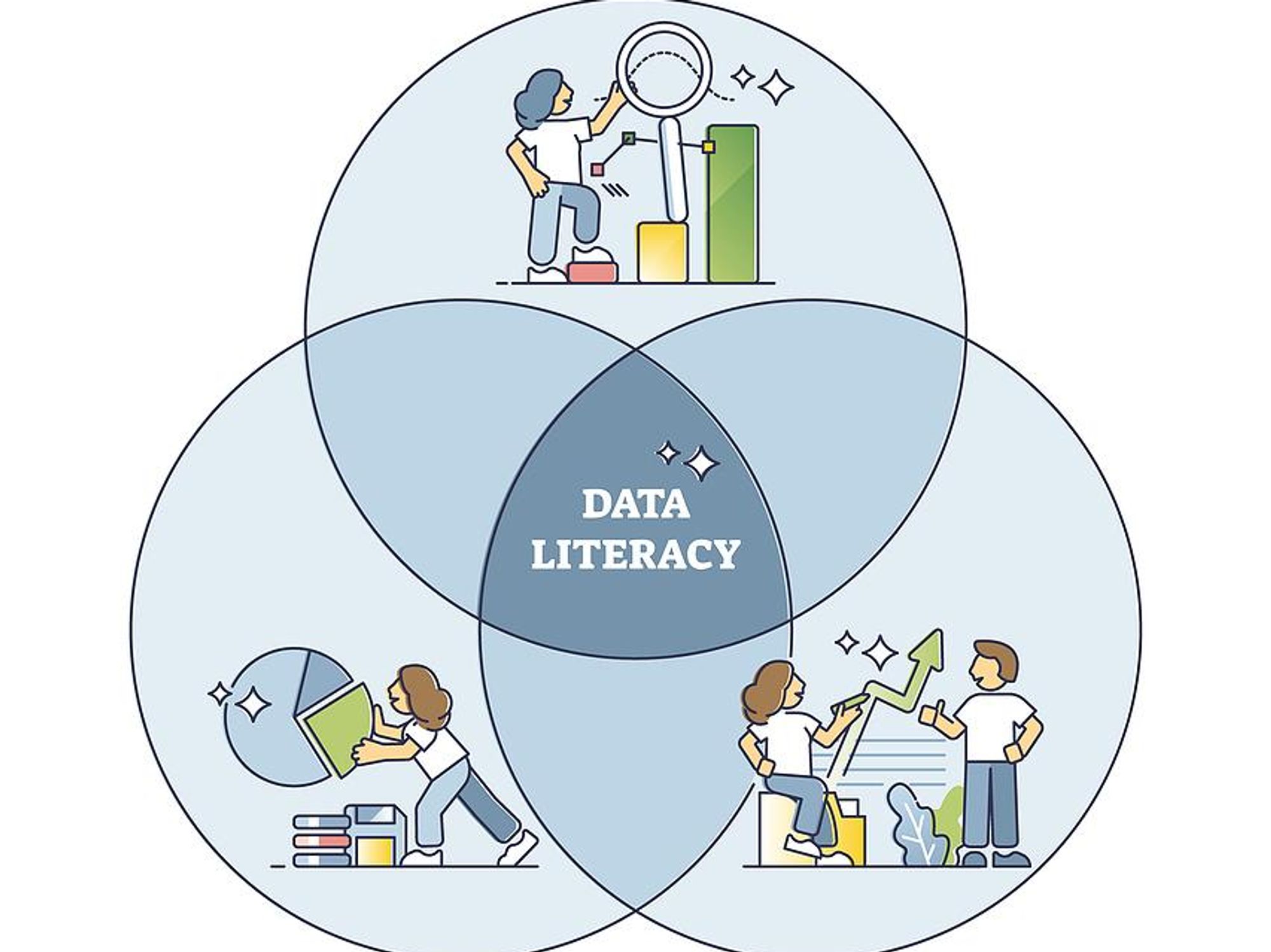
Some firms will launch a simple branding campaign that says, "What does the data tell us?" or "Listen to the data." While doing something is better than nothing, we would like to think rightfully or wrongly so that in 2022 most organizations are beyond this approach.
In this post, I posit that data literacy programs need a bit of a reset, given the current point of view on data literacy existed coming out of the age of business intelligence. In the age of AI, self-service analytics, and digital customer experience, what goes into a data literacy program needs to be reset, and the view of what users know about data and analytics needs to be reframed.
The Data Literacy Programs Of Yesteryear And Many Still Contain...

Bigstock
A curriculum that starts with, well, data is the currency of the times. It is the oil or glue that holds an organization together. Therefore, it is a strategic asset we must ensure is of quality, well-curated, and created correctly. These programs will then show how data is made, hopefully with examples/use cases from their business.
For instance, they will give a flow diagram of a customer service representative onboarding a customer and creating the initial customer record to show how an account should be set up and what happens if incorrect information is entered, or if the information is not filled in and left incomplete what that does to the ability to market and communicate with the customer.
This reminds me of Saturday morning cartoons I watched as a kid, where we learned about how a bill becomes a law. "I am only a bill sitting on capitol hill." While this is a valid use case from talking with business stakeholders, it borders on insulting as most people in their consumer life are engaging with a virtual assistant such as Alexa, wearing a smartwatch or tracking device such as an Apple Watch or a Fitbit, and using apps or other tools in their daily lives. Algorithms are everywhere, and people know them, and businesspeople know them as well. They understand what data is and how it drives consumer interactions. Many business stakeholders use operational dashboards and other data visualizations to run their businesses or departments. So, if we are ever to get into the world of insights to action and adaptive intelligence that industry researchers discuss, we need to go much further than using account setup examples. New examples such as how data analytics powers the guidance and advice advisors in a firm give customers through insight. Or how recommendation engines power next best actions which are sent to digital applications in real time are more modern relevant data analytics examples.
So, the time has come to rebrand data literacy, data analytics literacy so we can get more signals and patterns from the data we are collecting and move into improved decision-making.
So, What Is The Data Analytics Literacy Curriculum Of The Future Then?

Bigstock
I recommend that in the spirit of test and learn and lean start-up/design thinking; the firm develops a vehicle to assess what their audience knows: briefly, whether that is a survey and focus group or playing a fun game (like jeopardy or other skill-based assessment) to assess the knowledge and maturity level that can help you develop a new curriculum.
Using the outcome of the assessment above combined with the five critical focus areas I am proposing below can help set the stage for a world-class modern data analytics literacy program. The program could include:
1. Data Fundamentals: What are the components of master data management? Quality, governed, gold standard data. This includes a description of the business benefits of governing data and clearly explains the importance of domains such as lineage, business definitions, and the data catalog.
2. How Data Turns into Information and Knowledge. What platforms are required, and why do business users need to understand these fit-for-purpose platforms?
a. What are the benefits of cloud-based platforms, data lakes, or lake houses, and what data science workbenches do, as well as self-service analytics, and why are these tools important? Why should the firm invest in these?
b. Business users should appreciate data Infrastructure-as-a-Service and managed cloud data warehouse such as Snowflake and what they can do to improve end-user access and protect privacy. What is the difference between structured and unstructured data and how data models and platforms may be different depending on the data structure in question?
c. Digital, Marketing Automation, and CRM Fundamentals and Platforms. An appreciation of real-time decisioning and omnichannel customer engagement including how data analytics informs customer conversations, lead targeting and qualification, and overall knowing the customer.
3. Lean Start-Up and Design Thinking. Fundamentals of design thinking, test and learn, control groups, and how to measure the success of tests—quantitative and quantitative research. Why is it essential to create a baseline, and how do you set up good KPIs to improve performance?
4. Analytics Fundamentals. Starting with the importance of defining what business problem you are trying to solve and then moving to select the proper analytics methodologies. Go to market analytics, segmentation, and a basic overview of the types of analytics, from descriptive to predictive. Program-related analytics and measurement, customer lifetime value, and engagement. As a consumer of analytics, the businessperson should have a basic understanding of how specific analytics solve business problems. Depending on the firm and industry the types of potential analytics should be listed and explained in the context of potential application to help solve business problems. For example, if you are in a digital business, digital analytics and digital signals to sales and how you measure SEM/SEO should be discussed. If you are in a retail business, site placement and drive time analytics should be reviewed. If you are managing risk, transaction scoring and analysis using deep learning should be reviewed. If you are in a large consumer business with lots of cross-selling, various marketing analytics should be reviewed. Consider establishing a baseline through certifications such as INFORMS CAP.
5. AI and Data Science Fundamentals. Explain the difference between how statisticians think versus data scientists. How does machine learning enable AI applications? The types of AI and how to work with data scientists. What are good questions for data scientists when building statistically oriented products and services for you? How do you know the model or tool is good and working correctly? What are the various types of models that can be built and what do they solve?
Given we are now in 2022, it is time to upskill and move to data analytics literacy. I recommend that some type of handbook be developed for the above and the course also be available through video training and updated at least annually. Also, consider a modular approach to the curriculum design where you define the categories and then can keep adding topics and use cases. This program is a dynamic living breathing program and not a point-in-time project.
In summary, these five areas will help business users of data analytics drive more impact with insights through understanding what is possible with the applications and use cases of data analytics. These five areas are not the only ones, and I would like to hear from the readers of this newsletter about what domains or subjects could be added to this curriculum.
I look forward to hearing your thoughts on whether the time for this reset has come in the way data literacy programs are approached. Also please share any success stories or changes you are seeing in the marketplace. What has your experience been with these programs? Are you using any third parties or consultants to set these up? What role do HR and internal education teams play in designing and enabling these curricula?
- Chief Data Analytics Officer (CDAO): From Mindsets To Skills - Work ... ›
- The Important Steps Toward Achieving Data Governance - Work It ... ›
- How To Get Management Feeling Safe With Data In The Cloud ... ›
- Data Strategy Is More Important Than Ever In An Age Of AI - Work It ... ›
- Top 5 Questions To Answer To Get Your Data Strategy Right - Work ... ›
- How To Ensure The Data Mesh Doesn’t Create A Data Mess - Work It Daily ›
- How To Engage Customers In Real Time - Work It Daily ›
- The Data Science ROI Of Moving To The Data Lakehouse - Work It Daily ›

 Bigstock
Bigstock Bigstock
Bigstock Bigstock
Bigstock


